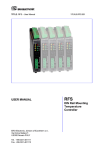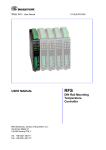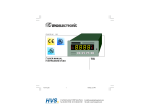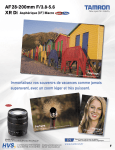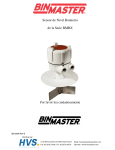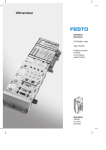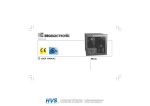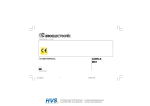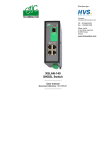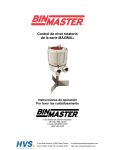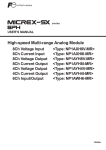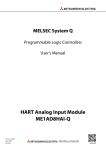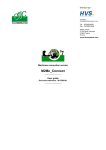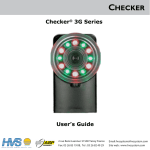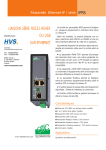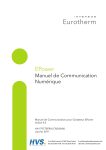Download USER MANUAL DIN Rail Mounting Temperature
Transcript
TITLE: RFS – User Manual USER MANUAL 170.IU0.RFS.001 RFS DIN Rail Mounting Temperature Controller ERO Electronic, division of Eurotherm s.r.l. Via Enrico Mattei 21 I-28100 Novara ITALY Tel. +39-0321-481111 Fax. +39-0321-481112 Page GB 2/51 TITLE: RFS – User Manual 2 rue René Laennec 51500 Taissy France Fax: 03 26 85 19 08, Tel : 03 26 82 49 29 170.IU0.RFS.00E E-mail:[email protected] Site web : www.hvssystem.com Page GB 3/51 TITLE: RFS – User Manual 170.IU0.RFS.00E Index MOUNTING REQUIREMENTS ..........................................................................................................4 OUTLINE DIMENSIONS ....................................................................................................................4 CONNECTION DIAGRAMS ...............................................................................................................4 ACCESSORIES.................................................................................................................................8 FUNCTIONALITY .............................................................................................................................11 SPECIAL FUNCTIONS DURING OPERATIVE MODE ...................................................................11 GENERAL NOTES ON THE MODBUS RTU PROTOCOL............................................................13 TRANSMISSION FORMAT ..............................................................................................................15 COMMUNICATION PROCEDURE..................................................................................................15 FUNCTION CODE 1 AND 2: BITS READING .................................................................................18 FUNCTION CODE 3 AND 4: WORDS READING ..........................................................................19 FUNCTION CODE 5: SINGLE BIT WRITING..................................................................................20 FUNCTION CODE 6: SINGLE WORD WRITING ...........................................................................21 FUNCTION CODE 8: DIAGNOSTIC................................................................................................22 FUNCTION CODE 15: MULTIPLE BITS WRITING .........................................................................23 FUNCTION CODE 16: MULTIPLE WORDS WRITING ..................................................................24 NOTES.............................................................................................................................................24 ERROR REPLY...............................................................................................................................27 DEVICE IDENTIFICATION GROUP (117).......................................................................................28 OPERATIVE GROUP (900).............................................................................................................29 DEVICE MANAGEMENT GROUP (1000)........................................................................................31 PROCESS VARIABLE INPUT GROUP (1100) ...............................................................................32 CURRENT TRANSFORMER INPUT AND ALARM GROUP (1200) ...............................................34 DIGITAL INPUT GROUP (1300) ......................................................................................................36 SETPOINT GROUP (1400) .............................................................................................................37 CONTROL (OUTPUT 1) GROUP (1500)........................................................................................40 SMART GROUP (1600)...................................................................................................................43 ALARM 1 (OUTPUT 2) GROUP (1700)...........................................................................................44 ALARM 2 (OUTPUT 3) GROUP (1800)...........................................................................................46 ALARM 3 (OUTPUT 4) GROUP (1900)...........................................................................................48 DIGITAL OUTPUTS GROUP (2000) ...............................................................................................50 COMMUNICATION GROUP (2100).................................................................................................51 GENERAL SPECIFICATIONS .........................................................................................................49 MAINTENANCE................................................................................................................................51 Page GB 4/51 TITLE: RFS – User Manual 170.IU0.RFS.00E MOUNTING REQUIREMENTS Fig. 1.B OUTLINE DIMENSIONS 117 22.5 101 120 8.5 131 Select a mounting location having the following characteristics: 1) it should be easy accessible 2) there is no vibrations or impact 3) there are no corrosive gases (sulphuric gas, ammonia, etc.). 4) there are no water or other fluid (i.e. condense) 5) the ambient temperature is in accordance with the operative temperature of the instrument (from 0 to 50 °C). 6) the relative humidity is in accordance with the instrument specifications ( 20% to 85 % non condensing). The instrument can be mounted on OMEGA DIN rail in accordance with EN 50 022 (35 x 7.5 mm or 35 x 15 mm) regulations. For outline dimensions refer to Fig. 2. MOUNTING 17 18 19 14 15 16 Fig. 2 OUTLINE DIMENSIONS 1 2 3 4 5 J4 7 8 9 10 11 12 13 8.5 23 22 21 20 J2 CONNECTION DIAGRAMS 1 2 3 4 5 J4 Fig. 1.A J2 17 18 19 14 15 16 7 8 9 10 11 12 13 REMOVING 7 8 9 10 11 12 13 14 15 16 23 22 21 20 J2 1 2 3 4 5 J4 23 22 21 20 Fig. 3 TERMINAL BLOCK 17 18 19 Page GB 5/51 TITLE: RFS – User Manual 170.IU0.RFS.00E 1) Don’t run input wires together with power cables. 2) Pay attention to the line resistance; a high line resistance (higher than 20 Ω/wire) may cause measurement errors. 3) If shielded cable is used, it should be grounded at one point only. 4) The resistance of the 3 wires must be the same. MEASURING INPUTS NOTE: Any external component (like zener barriers etc.) connected between sensor and input terminals may cause errors in measurement due to excessive and/or not balanced line resistance or possible leakage currents. LINEAR INPUT 20 + mA _ 22 TC INPUT Shield + 21 + 20 mA _ 22 _ 22 Shield + 21 Shield _ 22 Fig. 6.A mA INPUT WIRING Shield 21 + mV Fig. 4 THERMOCOUPLE INPUT WIRING 22 _ Shield NOTE: 1) Don’t run input wires together with power cables. 2) For TC wiring use proper compensating cable preferable shielded. 3) When a shielded cable is used, it should be connected at one point only. 21 + mV 22 _ Shield RTD INPUT Fig. 6.B 60mV INPUT WIRING RTD 23 Fig. 5 NOTE: 22 21 RTD 23 22 21 RTD INPUT WIRING NOTE: 1) Don’t run input wires together with power cables. 2) When shielded cable is used, it should be grounded at one side only to avoid ground loop currents. 3) For mV input, pay attention to the line resistance; a high line resistance may cause measurement errors. 4) The input impedance is equal to: < 5 Ω for 20 mA input. > 1 MΩ for 60 mV input. Page GB 6/51 TITLE: RFS – User Manual 170.IU0.RFS.00E LOGIC INPUT Safety note: 1) Do not run logic input wiring together with power cables. 2) Use an external dry contact capable of switching 5 mA, 7.5 V DC. 3) The instrument needs 100 ms to recognize a contact status variation. 4) The logic inputs is isolated by the measuring input. RELAY OUTPUTS OUT 1 18 C NO 19 C OUT 2 15 NO 16 NC IN 1 11 6 OUT 3 12 7 C NO 13 Fig. 7 - LOGIC INPUT WIRING Fig. 9 RELAY OUTPUTS WIRING This logic input can be programmed in order to perform the following functions: a) to switch from main set point to auxiliary set point and viceversa. logic input op. set point open main SP close auxiliary SP (SP2) b) to hold the set point ramp execution. logic input Ramp open RUN close HOLD The contact rating of the OUT 1, 2 and 3 is 3A/250V AC on resistive load. The number of operations is 3 x 105 at specified rating. NOTES 1) To avoid electrical shock, connect power line at the end of the wiring procedure. 2) For power connections use No 16 AWG or larger wires rated for at last 75 °C. 3) Use copper conductors only. 4) Don’t run input wires together with power cables. All relay contacts are protected by varistor against inductive load with inductive component up to 0.5 A. CURRENT TRANSFORMER INPUT 8 The following recommendations avoid serious problems which may occur, when using relay output for driving inductive loads. 9 Current transformer Load Fig. 8 CURRENT TRANSFORMER INPUT WIRING Note: 1) The input impedance is equal to 12 Ω. 2) The maximum input current is equal to 50 mA rms (50 / 60 Hz). 2 rue René Laennec 51500 Taissy France Fax: 03 26 85 19 08, Tel : 03 26 82 49 29 E-mail:[email protected] Site web : www.hvssystem.com Page GB 7/51 TITLE: RFS – User Manual 170.IU0.RFS.00E INDUCTIVE LOADS High voltage transients may occur switching inductive loads. Through the internal contacts these transients may introduce disturbances which can affect the performance of the instrument. For all the outputs, the internal protection (varistor) assures a correct protection up to 0.5 A of inductive component. The same problem may occur when a switch is used in series with the internal contacts as shown in Fig. 10. C power line R Maximum current = 20 mA. NOTE: This output is not isolated. A double or reinforced isolation between instrument output and power supply must be assured by the external solid state relay. SERIAL INTERFACE RS-485 interface allows you to connect slave 1 2 A/A’ B/B’ C/C’ Common 3 devices with one remote master unit. load Fig. 10 EXTERNAL SWITCH IN SERIES WITH THE INTERNAL CONTACT In this case it is recommended to install an additional RC network across the external contact as show in Fig. 10 The value of capacitor (C) and resistor (R) are shown in the following table. LOAD (mA) C (µF) R (Ω) P. (W) OPERATING VOLTAGE <40 mA 0.047 100 <150 mA 0.1 22 <0.5 A 0.33 47 1/2 2 2 260 V AC 260 V AC 260 V AC The cable involved in relay output wiring must be as far away as possible from input or communication cables. VOLTAGE OUTPUTS FOR SSR DRIVE + 18 OUT 1 _ + _ 19 SOLID STATE RELAY + 15 OUT 2 _ + _ 16 SOLID STATE RELAY Fig. 11 SSR DRIVE OUTPUT WIRING It is a time proportioning output. Logic level 0: Vout < 0.5 V DC. Logic level 1: - 14 V + 20 % @ 20 mA - 24 V + 20 % @ 1 mA. Fig. 12 - RS-485 WIRING NOTES: 1) The RFS is equipped with an RS-485 driver with an input impedance fore time higher than a standard one. For this reason it is possible to connect 120 RFS units to the same master (instead of 30). 1) The cable length must not exceed 1.5 km at 19200 BAUD. 2) This serial interface is isolated. 3) The following report describes the signal sense of the voltage appearing across the interconnection cable as defined by EIA for RS-485. a) The ” A ” terminal of the generator shall be negative with respect to the ” B ” terminal for a binary 1 (MARK or OFF) state. b) The ” A ” terminal of the generator shall be positive with respect to the ” B ” terminal for a binary 0 (SPACE or ON). 4) The EIA standard establishes that by RS-485 interface it is possible to connect up to 30 devices with one remote master unit. The serial interface of these instruments is based on “High input impedance” transceivers; this solution allows you to connect up to 120 devices (based on the same transceiver type) with one remote master unit. Page GB 8/51 TITLE: RFS – User Manual 2 rue René Laennec 51500 Taissy France Fax: 03 26 85 19 08, Tel : 03 26 82 49 29 170.IU0.RFS.00E E-mail:[email protected] Site web : www.hvssystem.com Page GB 9/51 TITLE: RFS – User Manual POWER LINE WIRING 5 POWER LINE 24 V A.C/DC 4 Fig. 13 POWER LINE WIRING NOTES: 1) Before connecting the instrument to the power line, make sure that line voltage corresponds to the description on the identification label. 2) Use copper conductors only. 3) Don’t run input wires together with power cables. 4) The power supply input is NOT fuse protected. Please, provide it externally. For one unit only, the fuse must be rated as follows: Power supply Type Current Voltage 24 V AC/DC T 315mA 250 V When fuse is damaged, it is advisable to verify the power supply circuit, so that it is necessary to send back the instrument to your supplier. 5) The maximum power consumption is equal to 6 VA (4 W) maximum. 170.IU0.RFS.00E ACCESSORIES BUS cable It is possible to use a screw connector instead of the flat cable, allowing the normal wiring of a single controller. This flat cable allows the simultaneous connection of the power supply, the serial interface, the common alarm output (out 4) and the common logic input of up to 12 instruments plus one Common I/O unit or up to 13 instruments. NOTE: 1) the logic inputs of each instrument can be driven: by its own connector (terminals 6 and 7), without affecting the working of the other elements by the common logic input (terminals 24 and 25) present on the common I/O unit. In this case, all instruments connected with the BUS cable will detect the same logic input condition. 2) The local logic input (terminals 6 and 7), and the common logic input (terminals 24 and 25), are in OR condition. BUS cable Fig. 14 – BUS CABLE The connector used is a MOLEX Europe with circuits Part number 39512163 16 Page GB 10/51 TITLE: RFS – User Manual 170.IU0.RFS.00E Fig. 15 – CONNECTOR 8 x 2 FOR BUS CABLE COMMON I/O UNIT This unit can perform 3 different functions: 1) It is the relay output of all the common alarm connected by the BUS cable. 2) It performs the connection of the common logic input of all the units connected by the BUS cable. 3) It is the natural connection of the power supply and of the serial link for all the units connected by the BUS cable. 1 2 3 4 5 24 25 J2 COMMON I/O UNIT D.IN D.IN D.IN D.IN 6 6 6 6 24 7 7 7 7 25 Fig. 18/A Common logic input OPEN RFS D.IN RFS D.IN RFS D.IN RFS D.IN 6 6 6 6 24 7 7 7 7 25 RFS RFS RFS RFS COMMON I/O UNIT Fig. 18/B Common logic input CLOSE 26 27 28 Fig. 16 - COMMON I/O UNIT TERMINAL BLOCK For serial interface and power supply connection see fig. 12 and 13 and relative notes. Common logic input Safety note: 1) Do not run logic input wiring together with power cables. 2) Use an external dry contact capable of switching 100 mA, 7.5 V DC minimum. 3) The instrument needs 100 ms to recognize a contact status variation. 4) The logic input is isolated by the measuring input. IN 1 24 25 Fig. 17 – COMMON LOGIC INPUT WIRING NOTE: As shown in Fig 18, the logic input of a group of RFS can be driven singularly (using terminals 6 and 7 of the specific instrument) or collectively (using terminals 24 and 25 of the Common I/O unit). This logic input can be programmed in order to perform the following functions: a) to switch from main set point to auxiliary set point and viceversa. logic input selected set point open main SP close auxiliary SP (SP2) b) to hold, the set point ramp execution. logic input Ramp open RUN close HOLD Page GB 11/51 TITLE: RFS – User Manual 170.IU0.RFS.00E Common alarm output Phoenix model MSTB 2.5/2-ST-5.08 NC 26 C 27 NO 28 Fig. 19 COMMON ALARM OUTPUT WIRING OFF ON V+ Out 4 From bus connector RFS RFS RFS RFS Fig. 22 - 3 wires connector 26 N.C. 27 COM 28 N.O. Phoenix model MSTB 2.5/3-ST-5.08 COMMON I/O UNIT Fig. 20/A Relay de-energized, beacon ON lit. OFF ON V+ Out 4 From bus connector RFS RFS RFS RFS 26 N.C. 27 COM 28 N.O. Fig. 23 - 4 wires connector NOTE: this connector is a gold plated connector and it is shipped with the instrument and it is not included in the connector kit. Phoenix model MSTB 2.5/4-ST-5.08 COMMON I/O UNIT Fig. 20/B Relay energized, beacon OFF lit. The contact rating of this output is 8A/250V AC on resistive load. The number of operations is 3 x 105 at specified rating. NOTE Don’t run input wires together with power cables. The relay contacts are protected by varistor against inductive load with inductive component up to 0.5 A. Fig. 24 - 5 wires connector Phoenix model MSTB 2.5/5-ST-5.08 CONNECTOR KIT The unit can be supplied with or without the connector kit. The quantity of each connector is related with the specific options selected. Fig. 25 - 8 wires connector Phoenix model MSTB 2.5/8-ST-5.08 Fig 21 – 2 wires connector Page GB 12/51 TITLE: RFS – User Manual 170.IU0.RFS.00E FUNCTIONALITY Operating modes description The device foresees three different operating modes named: - Calibration mode - Configuration mode - Operative mode The calibration mode This operating mode is detailed in a specific manual named “RFS Calibration manual”. The configuration mode During configuration mode the instrument does not perform the process control and the alarms functions. During configuration it is possible to read and write all the parameters of the instrument. The instrument configuration can be made by RS485 or by a specific tool named CPI. NOTE the standard RS-485 and the CPI are mutually exclusive and the CPI have the priority with respect of the RS-485. The CPI is shipped with a special software aimed to made the configuration procedure very easy. The CPI and the RFS configuration program are described in a specific manual. In the chapter “RFS Modbus protocol” you will find all the information related with the various parameters (when it can be write or read, limits, and so on). The operative mode During operative mode the instrument performs the process control and the alarms management and all the other special functions (SMART, soft start, etc.). During Operative mode it is possible to read and write a subset of parameters. SPECIAL FUNCTIONS DURING OPERATIVE MODE Follows a list of the special functions perform by this instrument. It aims to help you during configuration and operative mode in order to obtain the best performance from this instrument. NOTE: in the following descriptions two square brackets are used to define the Modbus address of a parameter. Indicators 1 Lit when OUT 1 is ON. 2 Lit when OUT 2 is ON. 3 Lit when OUT 3 is ON. 4 Lit when OUT 4 is ON. PV FAIL Lit when a failure is detected on the measuring input. COM Lit during transmission. SYS Flashing during operative mode Lit during configuration and calibration mode. D.IN lit when the logic input is closed Enable/disable the control output When the instrument is in operative mode, it is possible to disable the control outputs [1504]. In this open loop mode the device will function as an indicator, the instrument will perform the measure but all control outputs will be forced to 0. When the control outputs are disabled the alarms are also in no alarm condition. If a power down occurs when the control output is disabled, at instrument power up the control output will be automatically disabled. When the control is restored the instrument operates as in presence of a power up and the alarm mask function, if configured, will be activated. MANUAL function The MANUAL mode function [1503] allows to set directly the power output of the instrument. The transfer from AUTO to MANUAL and viceversa is bumpless (this function is not provided if integral action is excluded). If transfer from AUTO to MANUAL is performed during the first part of SMART algorithm (TUNE) when returning in AUTO the device will be forced automatically in the second part of the SMART algorithm (ADAPTIVE). At power up the device will be in the AUTO mode or as it was left prior to power shut down depending on [1521] configuration selection. Note: When start up occurs in Manual mode the power output (OUT1 - OUT2) is set to 0. SMART function It is used to automatically optimize the control action. When the SMART function is enabled, it is possible to read but not to write the control parameters (Pb, Ti, Td). Page GB 13/51 TITLE: RFS – User Manual 170.IU0.RFS.00E Disabling the SMART function, the instrument maintains the actual set of control parameters and it enables parameter modification. NOTES: When ON/OFF control is programmed (Pb=0), the SMART function is disabled. Energy management at start up Synchronous pre-heating This function eliminates differential heating during machine start up due to differing heating rates of individual heaters. This function operate as follows: At instrument start up all controllers use the first measured value as initial set point and than they start a ramp from this set point to the final set point previously programmed. All common alarms are set as band alarms and are connected with the common logic input. In this way if the measure of one loop goes out of the tracking band, the common alarm will close the common logic input and the ramp execution of all the loops will be hold. The ramp execution will restart when all measures come back in the tracking band. In order to obtain this function, set the instruments as follows: 1) The alarm 3 is a band alarm ([1903] = 2, [1904] = 0, [1905] = 0, [1906] = 0 and [1907] = 0) 2) The “operative set point at start up” must be set equal to “aligned to the measured value” ([1410] = 1) 3) The logic input is used for ramp hold ([1301] = 2) 4) The “rate of change for positive set point variation” [1408] and the “rate of change for negative set point variation” [1409] must be set between 1 and 100 digit per minute according with the desired rate of change. 5) The common alarm output is connected with the common logic input. Sequential address (Modbus) for frequently accessed parameter. To maximize the data transfer rates between the RFS and the host supervisory system important operating parameters are grouped with sequential address (see operative group [900]). To further increase data transfer efficiency, all digital status information are transferred as one data word. The system enables the RFS to communicate relevant parameter information with a single data request, not a series of separate address operations. When you turn ON a multi-loops machine where all loops have the soft start function, at power up the ON and OFF period of the control output of all loops will be (more or less) synchronous. This fact produces high current peaks. These instruments will use their Modbus address (all addresses are different) in order to displace the ON and OFF period of the control output(s). This facility significantly reduces maximum machine start-up current requirements and offers potential savings in electrical installation capacity and cable requirements. Availability of the not used I/O by serial link All RFS I/O may be read directly over the Modbus communication interface by the host supervisory system. Additionally, the communication host may write to RFS outputs that are not assigned as alarm or output functions. This facility expands available PLC and host supervisory system I/O, simplifies machine troubleshooting and provides the possibility to perform remote diagnostics. OFD function – Output failure detection (optional) Using the CT input the output failure detection function monitors the current in the load driven by the output 1. Load and actuator protection is provided in the following way: - During the ON period of the output, the instrument measures the current through the load and it generates an alarm condition if this current is lower than a pre-programmed threshold [1206]. A low current shows a partial or total break down of the load or actuator SSR. - During the OFF period of the output, the instrument measures the leakage current through the load and it generates an alarm condition when this current is higher than a preprogrammed threshold value[1205]. A high leakage current shows a short circuit of the actuator. Page GB 14/51 TITLE: RFS – User Manual “Soft start” function This function allows to gradually warm up the machine during start up in order to delete thermal strength and to protect the raw material. 170.IU0.RFS.00E The energy applied is restricted (by [1514]) for a programmable time [1515]. 2 rue René Laennec 51500 Taissy France Fax: 03 26 85 19 08, Tel : 03 26 82 49 29 E-mail:[email protected] Site web : www.hvssystem.com Page GB 15/51 TITLE: RFS – User Manual 170.IU0.RFS.00E GENERAL NOTES ON THE MODBUS RTU PROTOCOL This half duplex protocol accepts one master and one or more slaves. The physical interface should be of the RS-485 type. A single multidrop link can take up to 120 devices having the same "High input impedance" as the transceiver used. The computer must be programmed to serve as a master controlling which slave has access to the link. All other slaves are in waiting state. Each slave has a unique address ranging from 1 to 254. Address "0" is a broadcast one. When the master sends a message with address "0", all slaves receive it and no one replies. NOTE: The numerical value present in this text are expressed as: - binary value if they are followed by b - decimal value if they are not followed by any letter - hexadecimal value if they are followed by h TRANSMISSION FORMAT The protocol uses the RTU (Remote terminal unit) mode of transmission. RTU is a binary method with byte format composed as follows: 1 start bit, 8 data bit, 1 parity bit (optional), 1 stop bit. The communication speed is selectable among 600, 1200, 2400, 4800, 9600 and 19200 baud. NOTE: If CPI (Configuration Port Interface) is used the transmission format is fixed (19200 - 8 bits – No parity) and the address is fixed at 255 The broadcast address (0) is not admitted COMMUNICATION PROCEDURE The communication can be initiated only by the master unit; the slave units can transmit only after a query has been received from the master. The general format for the transmission from master to slave is the following: RANGE Slave address Function code Data Error check (CRC-16) (low byte) Error check (CRC-16) (high byte) BYTE 1 1 n 1 1 The slave detects the start of a query frame when the delay time between two characters is greater than 3.5 T.U. (Time Unit = Time necessary to transmit one character). 2 rue René Laennec 51500 Taissy France Fax: 03 26 85 19 08, Tel : 03 26 82 49 29 E-mail:[email protected] Site web : www.hvssystem.com Page GB 16/51 TITLE: RFS – User Manual 170.IU0.RFS.00E ERROR CHECK (CRC-16 Cyclical Redundancy Check) The CRC-16 value is calculated by the transmitting device. This value is appended to the message. The receiving device recalculates a CRC-16 and compares the calculated value to the received value. The two values must be equal. The CRC-16 is started by first pre-loading a 16-bit register to all 1's. Then a process begins of applying successive the bytes of the message to the current contents of the register. Only the eight bits of data in each character are used for generating the CRC-16. Start and stop bits, and the parity bit if one is used, do not apply to the CRC-16. During generation of the CRC-16, each byte is exclusive ORed with the register contents. Then the result is shifted to the right , with a zero filled into the most significant bit (MSB) position. If the LSB was a 1, the register is then exclusive ORed with a preset, fixed value. If the LSB was a 0, no exclusive OR takes place. This process is repeated until eight shifts have been performed. After the last shift, the next byte is exclusive ORed with the register's current value, and the process repeats for eight more shifts as described above. The final contents of the register, after all the characters of the message have been applied, is the CRC-16 value. A procedure for generating a CRC-16 is: 1) Load a 16-bit register (CRC-16 register) with FFFFh (all 1's). 2) Exclusive OR the first byte of the message with the low byte of the CRC-16 register. Put the result in the CRC-16 register. 3) Shift the CRC-16 register one bit to the right (toward the LSB), zero-filling the MSB. Extract and examine the LSB. 4) (If the LSB was 0): Repeat Step 3 (another shift). (If the LSB was 1): Exclusive OR the CRC-16 register with the polynomial value A001h (1010 0000 0000 0001b). 5) Repeat Steps 3 and 4 until 8 shifts have been performed. When this is done, a complete byte will have been processed. 6) Repeat Steps 2 through 5 for the next byte of the message. Continue doing this until all bytes have been processed. 7) The final contents of the CRC-16 register is the CRC-16 value. When the CRC-16 (16 bytes) is transmitted in the message, the low byte will be transmitted first, followed by the high byte. 2 rue René Laennec 51500 Taissy France Fax: 03 26 85 19 08, Tel : 03 26 82 49 29 E-mail:[email protected] Site web : www.hvssystem.com Page GB 17/51 TITLE: RFS – User Manual 170.IU0.RFS.00E An example of a C language function performing CRC generation is shown below. /* --------------------------------------------------------------crc_16 calculate the crc_16 error check field Input parameters: buffer: string to calculate CRC length: bytes number of the string This function returns the CRC value. --------------------------------------------------------------- */ unsigned int crc_16 (unsigned char *buffer, unsigned int length) { unsigned int i, j, temp_bit, temp_int, crc; crc = 0xFFFF; for ( i = 0; i < length; i++ ) { temp_int = (unsigned char) *buffer++; crc ^= temp_int; for ( j = 0; j < 8; j++ ) { temp_bit = crc & 0x0001; crc >>= 1; if ( temp_bit != 0 ) crc ^= 0xA001; } } return (crc); } 2 rue René Laennec 51500 Taissy France Fax: 03 26 85 19 08, Tel : 03 26 82 49 29 E-mail:[email protected] Site web : www.hvssystem.com Page GB 18/51 TITLE: RFS – User Manual 170.IU0.RFS.00E Function code 1 and 2: Bits reading These function codes are used by the master unit to request the value of a consecutive group of bits (max 24) which are representing the status of the slave unit. Request from master to slave Range Byte Slave address (1-255) 1 Function code (01-02) 1 Bit starting address (high byte) 1 Bit starting address (low byte) 1 Number of bits (high byte) 1 Number of bits (low byte) 1 Error check (CRC-16) (low byte) 1 Error check (CRC-16) (high byte) 1 Reply from slave to master Range Byte Slave address (1-255) 1 Function code (01-02) 1 Byte counter (n) 1 Data n Error check (CRC-16) (low byte) 1 Error check (CRC-16) (high byte) 1 The "Data" field indicates the bits requested: the bit with lower address is in the bit 0 of the first byte, the next is in the bit 1, and so on. The eventual don’t care bits necessary to complete the last byte are equal to 0. Example: Ask to slave at address 3 (3h) the status of 4 (4h) bits starting from bit 2000 (7D0h) “Digital outputs group”. Request from master to slave Range Byte Slave address 03h Function code 01h Bit starting address (high byte) 07h Bit starting address (low byte) D0h Number of bits (high byte) 00h Number of bits (low byte) 04h Error check (CRC-16) (low byte) 3Ch Error check (CRC-16) (high byte) A6h Reply from slave to master Range Slave address Function code Byte counter Data Error check (CRC-16) (low byte) Error check (CRC-16) (high byte) The byte in "Data" field (0Ah=000001010b) means: Bit 2000 status Bit 2001 status Bit 2002 status Bit 2003 status Don’t care Don’t care Don’t care Don’t care = = = = = = = = 0 1 0 1 0 0 0 0 Status of output 1, output not energized Status of output 2, output energized Status of output 3, output not energized Status of output 4, output energized Byte 03h 01h 01h 0Ah D0h 37h Page GB 19/51 TITLE: RFS – User Manual 170.IU0.RFS.00E Function code 3 and 4: Words reading These function codes are used by the master unit to read a consecutive group of words (16 bit) which contain the value of the variable of the slave unit. The master can require a maximum of 20 words at a time. Request from master to slave Range Byte Slave address (1-255) 1 Function code (03-04) 1 Word starting address (high byte) 1 Word starting address (low byte) 1 Number of word (high byte) 1 Number of word (low byte) 1 Error check (CRC-16) (low byte) 1 Error check (CRC-16) (high byte) 1 Reply from slave to master Range Byte Slave address (1-255) 1 Function code (03-04) 1 Byte counter (n) 1 Data n Error check (CRC-16) (low byte) 1 Error check (CRC-16) (high byte) 1 The "Data" field contains the requested words in the following format: high byte of the first word, low byte of the first word, high byte of the second word, and so on. The "Data" field contains 8000h for not implemented addresses or for information not relevant in the actual device configuration. Example: Ask to slave at address 1 (1h) the value of 3 (3h) words starting from word 1100 (44Ch) “Process variable input group”. Request from master to slave Range Byte Slave address 01h Function code 03h Word starting address (high byte) 04h Word starting address (low byte) 4Ch Number of words (high byte) 00h Number of words (low byte) 03h Error check (CRC-16) (low byte) C5h Error check (CRC-16) (high byte) 2Ch Reply from slave to master Range Slave address Function code Byte counter Data Data Data Data Data Data Error check (CRC-16) (low byte) Error check (CRC-16) (high byte) Byte 01h 03h 06h 00h 1Dh 00h 1Dh 00h 03h 1Dh 70h The 6 bytes in "Data" field (00h, 1Dh, 00h, 1Dh, 00h, 03h) are 3 words whose meaning is: Word 1100 value = 29 (1Dh) Word 1101 value = 29 (1Dh) Word 1102 value = 3 (3h) Input variable without filter, 29 °C Filtered input variable, 29 °C Input type and range value for main input, Tc J –100 ÷ 1000°C Page GB 20/51 TITLE: RFS – User Manual 170.IU0.RFS.00E Function code 5: Single bit writing By using this command, the master unit can change the state of one bit of the slave unit. Command from master to slave Range Byte Slave address (0*-255) 1 Function code (05) 1 Bit address (high byte) 1 Bit address (low byte) 1 Data 2 Error check (CRC-16) (low byte) 1 Error check (CRC-16) (high byte) 1 Reply from slave to master Range Byte Slave address (1-255) 1 Function code (05) 1 Bit address (high byte) 1 Bit address (low byte) 1 Data 2 Error check (CRC-16) (low byte) 1 Error check (CRC-16) (high byte) 1 * To use the address 0, see note 1 (“Broadcast” address) in the “Notes” section. "Data" field = 0h to reset the bit = FF00h to set the bit Example: Set bit 1003 (3EBh) of slave at address 35 (23h), “Manual reset of an alarm condition” in “Device management group”. Command from master to slave Range Byte Slave address 23h Function code 05h Bit address (high byte) 03h Bit address (low byte) EBh Data FFh Data 00h Error check (CRC-16) (low byte) FAh Error check (CRC-16) (high byte) C8h Reply from slave to master Range Slave address Function code Bit address (high byte) Bit address (low byte) Data Data Error check (CRC-16) (low byte) Error check (CRC-16) (high byte) 2 rue René Laennec 51500 Taissy France Fax: 03 26 85 19 08, Tel : 03 26 82 49 29 Byte 23h 05h 03h EBh FFh 00h FAh C8h E-mail:[email protected] Site web : www.hvssystem.com Page GB 21/51 TITLE: RFS – User Manual 170.IU0.RFS.00E Function code 6: Single word writing By using this command, the master unit can change the value of one word (16 bit) of the slave unit. Command from master to slave Range Byte Slave address (0*-255) 1 Function code (06) 1 Word address (high byte) 1 Word address (low byte) 1 Data 2 Error check (CRC-16) (low byte) 1 Error check (CRC-16) (high byte) 1 Reply from slave to master Range Byte Slave address (1-255) 1 Function code (06) 1 Word address (high byte) 1 Word address (low byte) 1 Data 2 Error check (CRC-16) (low byte) 1 Error check (CRC-16) (high byte) 1 * To use the address 0, see note 1 (“Broadcast” address) in the “Notes” section. The 8000h value, present in the "Data" field, should be considered as a don’t care value, that is, the value present in the device at this address will not be modified. Example: Set word 1403 (57Bh) of slave at address 1 (1h) with value 240 (F0h), “Main set point” in “Setpoint group”. Command from master to slave Range Byte Slave address 01h Function code 06h Word address (high byte) 05h Word address (low byte) 7Bh Data 00h Data F0h Error check (CRC-16) (low byte) F9h Error check (CRC-16) (high byte) 5Bh Reply from slave to master Range Slave address Function code Word address (high byte) Word address (low byte) Data Data Error check (CRC-16) (low byte) Error check (CRC-16) (high byte) 2 rue René Laennec 51500 Taissy France Fax: 03 26 85 19 08, Tel : 03 26 82 49 29 Byte 01h 06h 05h 7Bh 00h F0h F9h 5Bh E-mail:[email protected] Site web : www.hvssystem.com Page GB 22/51 TITLE: RFS – User Manual 170.IU0.RFS.00E Function code 8: Diagnostic By using this command, the master unit can check the communication system to Slaves. Request from master to slave Range Byte Slave address (1-255) 1 Function code (08) 1 Sub-function (high byte) 1 Sub-function (low byte) 1 Data 2 Error check (CRC-16) (low byte) 1 Error check (CRC-16) (high byte) 1 Reply from slave to master Range Byte Slave address (1-255) 1 Function code (08) 1 Sub-function (high byte) 1 Sub-function (low byte) 1 Data 2 Error check (CRC-16) (low byte) 1 Error check (CRC-16) (high byte) 1 The Sub-function code will not be processed by Slave, any code is accept. The Sub-function code and data passed in the request is returned (looped back) in the slave replay. The entire replay message is identical to the request Example: Request from master to slave Range Byte Slave address 01h Function code 08h Sub-function (high byte) 00h Sub-function (low byte) 00h Data 55h Data AAh Error check (CRC-16) (low byte) 5Fh Error check (CRC-16) (high byte) 24h Reply from slave to master Range Slave address Function code Sub-function (high byte) Sub-function (low byte) Data Data Error check (CRC-16) (low byte) Error check (CRC-16) (high byte) 2 rue René Laennec 51500 Taissy France Fax: 03 26 85 19 08, Tel : 03 26 82 49 29 Byte 01h 08h 00h 00h 55h AAh 5Fh 24h E-mail:[email protected] Site web : www.hvssystem.com Page GB 23/51 TITLE: RFS – User Manual 170.IU0.RFS.00E Function code 15: Multiple bits writing This function code is used by master unit to set/reset a consecutive group of bits (Max 24). Command from master to slave Range Byte Slave address (0*-255) 1 Function code (15) 1 Bit starting address (high byte) 1 Bit starting address (low byte) 1 Number of bits (high byte) 1 Number of bits (low byte) 1 Byte counter (n) 1 Data n Error check (CRC-16) (low byte) 1 Error check (CRC-16) (high byte) 1 Reply from slave to master Range Byte Slave address (1-255) 1 Function code (15) 1 Bit starting address (high byte) 1 Bit starting address (low byte) 1 Number of bits (high byte) 1 Number of bits (low byte) 1 Error check (CRC-16) (low byte) 1 Error check (CRC-16) (high byte) 1 * To use the address 0, see note 1 (“Broadcast” address) in the “Notes” section. The desired status of each bit is packed in the "Data" field (1 = ON, 0 = OFF). The status imposed for read only bits will be ignored. The command will be processed starting from the first bit and it will be executed or not executed depending on the actual device status. At the first error found, the command will be aborted and the slave will answer with an error. Example: Send to slave, at address 2 (2h), the following set of 2 bits: Bit 2002 (7D2h) status = 0 (bit 0) Status of output 3, output not energized Bit 2003 (7D3h) status = 1 (bit 1) Status of output 4, output energized Filler = 0 (bit 2) Filler = 0 (bit 3) Filler = 0 (bit 4) Filler = 0 (bit 5) Filler = 0 (bit 6) Filler = 0 (bit 7) NOTE: 1 byte with 2 bits and 6 filler bits must be sent Command from master to slave Range Byte Slave address 02h Function code 0Fh Bit starting address (high byte) 07h Bit starting address (low byte) D2h Number of bits (high byte) 00h Number of bits (low byte) 02h Byte counter 01h Data 02h Error check (CRC-16) (low byte) A6h Error check (CRC-16) (high byte) E6h Reply from slave to master Range Slave address Function code Bit starting address (high byte) Bit starting address (low byte) Number of bits (high byte) Number of bits (low byte) Error check (CRC-16) (low byte) Error check (CRC-16) (high byte) Byte 02h 0Fh 07h D2h 00h 02h 75h 74h Page GB 24/51 TITLE: RFS – User Manual 170.IU0.RFS.00E Function code 16: Multiple words writing This function code is used by the master unit to write a consecutive group of words . The master unit can change a maximum of 20 words at a time. Command from master to slave Range Byte Slave address (0*-255) 1 Function code (16) 1 Word starting address (high byte) 1 Word starting address (low byte) 1 Number of words (high byte) 1 Number of words (low byte) 1 Byte counter (n) 1 Data n Error check (CRC-16) (low byte) 1 Error check (CRC-16) (high byte) 1 Reply from slave to master Range Byte Slave address (1-255) 1 Function code (16) 1 Word starting address (high byte) 1 Word starting address (low byte) 1 Number of words (high byte) 1 Number of words (low byte) 1 Error check (CRC-16) (low byte) 1 Error check (CRC-16) (high byte) 1 * To use the address 0, see note 1 (“Broadcast” address) in the “Notes” section. The data imposed for read only words will be ignored. The command will be processed starting from the first word and it will be executed or not executed depending on the actual device status. At the first error found, the command will be aborted and the slave will answer with an error. The 8000h value, present in the "data" field, should be considered as a don’t care value, this is, the value present in the device at this address will not be modified. Example: Set words 1505 (5E1h), 1506 (5E2h), 1507 (5E3h) of slave at address 10 (Ah) with 40 (28h), don’t care (8000h) and 300 (12Ch) values; “Proportional band”, “Hysteresis” and “Integral time” in “Control group”. Command from master to slave Range Byte Slave address 0Ah Function code 10h Word starting address(high byte) 05h Word starting address (low byte) E1h Number of words (high byte) 00h Number of words (low byte) 03h Byte counter 06h Data 00h Data 28h Data 80h Data 00h Data 01h Data 2Ch Error check (CRC-16) (low byte) F1h Error check (CRC-16) (high byte) DFh Reply from slave to master Range Slave address Function code Word starting address (high byte) Word starting address (low byte) Number of words (high byte) Number of words (low byte) Error check (CRC-16) (low byte) Error check (CRC-16) (high byte) Byte 0Ah 10h 05h E1h 00h 03h D1h 89h Page GB 25/51 TITLE: RFS – User Manual 170.IU0.RFS.00E NOTES 1. "Broadcast" address When using the writing codes (5, 6, 15 and 16) the slave address 0 is permitted: in this case all the slaves connected accept the command but do not give any reply. 2. Words format Every time the information transfer is performed by using 2 bytes (1 word of 16 bits), the first byte transmitted is the most significant one. For the negative numbers the "two complement" format is used. 3. Reply time The slave will start to send a reply from 2 ms to 700 ms after the end of the request detected by counting the received bytes. 4. Decimal digits The decimal point that may be present in the value is ignored. Example: The value 204.6 is transmitted as 2046 (07FEh) The value -12.50 is transmitted as -1250 (FB1Eh) The number of decimal digits, if significant, is stated for each parameter (see the DEC column in the parameters tables). Some parameters have a variable number of decimal digits according to the configuration, as described below: PV number of decimal digits apply on process variable [1105] CT number of decimal digits apply on current transformer read-out [1211] OP number of decimal digits apply on output power [1524] 5. Local/remote status In this controller, unlike other Ero Electronic devices, the “Local/remote status” setting isn’t required. This means that the master unit can modify any parameters without set any local/remote status bit, moreover no “3 seconds timeout” will be applied. 6. Operative mode "Operative mode" indicates the normal functioning status of the device (controller). In operative mode the master can read the whole parameters; the device returns 8000h for the meaningless one (for example: the threshold of a not configured alarm). The write operation is allowed only for a restricted number of parameters (for example: isn’t permitted to change the input configuration). In operative mode the controller checks the write data to be within the allowable limits (for example: the main set point must be inside the set point low and high limits). 7. Configuration mode “Configuration mode” is intended to set-up the device, then the controller doesn’t work. In configuration mode the master can read and write the whole parameters. In configuration mode, unlike the operative mode, the device returns always a value for each parameters, even for the meaningless one; this is intended to clone exactly the unit. Moreover, no check is done by the device receiving parameters; it’s under the responsibility of the master to send a valid set of parameters. If the master fails to follow the above rule, it will be impossible to switch the controller in operative mode until the whole set of parameters will be valid. 8. Read / write access permissions The access permissions are stated for each parameter in the description tables by means of two columns named “read” and “write” according the following meaning: O access allowed in operative mode C access allowed in configuration mode L access allowed in calibration mode F access allowed in factory test mode Page GB 26/51 TITLE: RFS – User Manual 9. Software key for lock/unlock control parameters Due to the lack of frontal panel, no one protection scheme is available for this device. 10. Address space The whole variables are addressable as word as well as bit; the user may choose the better way according to the condition. Although we suggest to manage analog variables as words and boolean variables as bits, below is described the behavior to access analog variables (example: alarm threshold) as bits and boolean variables (example: alarm status) as words. - Reading analog variables as bits: if the variable is not relevant in the actual device configuration (word value 8000h) or if the value is zero the bit is reset, otherwise the bit is set. - Writing analog variables as bits: the reset bit means 0000h, the set bit means 0001h. - Reading boolean variables as words: a reset variable is reported as 0000h, a set one is reported as 0001h. - Writing boolean variables as words: send 0000h to reset the variable, send a value different from 0000h and 8000h to set the variable. 170.IU0.RFS.00E 11. Communication parameters at start up. When it is desired to regain the control of an instrument with an unknown set of communication parameter, you can operate in two different way: 11.1. Make use of the CPI adapter. The instrument automatically recognizes the CPI adapter and it will use the following communication parameter set: - Address = 255 - Baud rate = 19200 - Bite format = 8 bit without parity NOTE: this is a fixed parameters set and it is not configurable. 11.2. At power up the instrument will start using the same communication parameter set used in presence of the CPI adapter. - If the instrument receives a correct Modbus request within the first 3 seconds, it will continue to operate with the same communication parameters. - If, during the 3 seconds time-out, the instrument doesn’t receive a correct request, it will set-up the communication interface with the parameter values previously programmed. 2 rue René Laennec 51500 Taissy France Fax: 03 26 85 19 08, Tel : 03 26 82 49 29 E-mail:[email protected] Site web : www.hvssystem.com Page GB 27/51 TITLE: RFS – User Manual 170.IU0.RFS.00E ERROR REPLY If the "error check" is wrong or the function code is not implemented or a buffer overflow has been received, the slave does not send any reply to the master. If other errors are detected in the request or command frame, or the slave cannot reply with the requested values or it cannot accept the requested sets because it is in error condition, the slave replies by forcing at "1" the bit 7 of the received "Function code" byte followed by an error code. Error reply (from slave to master) RANGE Slave address Function code (+80h) Error code Error check (CRC-16) (low byte) Error check (CRC-16) (high byte) BYTE 1 1 1 1 1 List of error codes ERROR CODE 2 3 9 10 DESCRIPTION Illegal data address Illegal data value Illegal number of data required The parameter indicated cannot be modified or command cannot be executed Error 2 is issued only when the whole addresses involved in a read or write operation are not implemented on the device. 2 rue René Laennec 51500 Taissy France Fax: 03 26 85 19 08, Tel : 03 26 82 49 29 E-mail:[email protected] Site web : www.hvssystem.com Page GB 28/51 TITLE: RFS – User Manual 170.IU0.RFS.00E DEVICE IDENTIFICATION GROUP (117) Modbus Address 117 118 119 DESCRIPTION FIRMWARE DEVICE CLASS Availability: Always Value: 413 for RFS FIRMWARE DEVICE LETTER Availability: Always Value: ‘A’ (41h) FIRMWARE REVISION Availability: Always Value: Nr. of firmware revision Manufactured trade mark 120 50 (32h) R E A D W R I T E D E C OC LF OC LF OC LF OC LF Device identification code 121 OC Note: Number of software revision x 100 + identification L F code 54 ( 36h ) 122 Serial firmware identification code Availability: Always Value: 0 2 rue René Laennec 51500 Taissy France Fax: 03 26 85 19 08, Tel : 03 26 82 49 29 OC LF E-mail:[email protected] Site web : www.hvssystem.com Page GB 29/51 TITLE: RFS – User Manual 170.IU0.RFS.00E OPERATIVE GROUP (900) Note: On this group are repeated some information present in other groups. The purpose of this is to have these information at consecutive address. This solution allows to maximize the data transfer rates between the RFS and the host supervisory system. R W Modbus A R R Default Address DESCRIPTION N E I D Value G A T E E D E C OUT 1 Leakage current measure value (in Ampere) 900 O CT (Same as address 1201) OUT 1 Load current measure value (in Ampere) 901 O CT (Same as address 1203) OUT 2 value (in %) 902 0 / 100 O O OP (Same as address 1501) OUT 1 value (in %) 903 0 / 100 O O OP (Same as address 1500) STATUS D15 = OUT 1 Leakage current measure updating (See address 1202) (0 = Measure updated) (1 = Measure not updated) D14 = 0 (Reserved) D13 = Status alarm 3 (0 = No alarm 1 = Alarm) D12 = Status alarm 2 (0 = No alarm 1 = Alarm) D11 = Status alarm 1 (0 = No alarm 1 = Alarm) D10 = Status CT alarm 904 (0 = No alarm 1 = Alarm) D 9 = OUT 1 Load current measure updating (See address 1204) (0 = Measure updated) (1 = Measure not updated) D 8=0 (Reserved) D 7 = Status of Out 4 ( 0 = Out not energized 1 = Out energized ) D 6 = Status of Out 3 ( 0 = Out not energized 1 = Out energized ) D 5 = Status of Out 2 ( 0 = Out not energized 1 = Out energized ) D 4 = Status of Out 1 ( 0 = Out not energized 1 = Out energized ) D 3 = Digital input status ( 0 = Contact open 1 = Contact closed) D 2 = Auto / Manual ( 0 = Auto 1 = Manual) D 1 = control output Enabled or disabled ( 0 = Enabled 1 = Disabled) D 0 = SMART Enable or Disable ( 0 = Disabled 1 = Enabled) O Page GB 30/51 TITLE: RFS – User Manual Modbus Address DESCRIPTION 170.IU0.RFS.00E R A N G E R E A D W R I T E D E C Default Value Filtered Input variable (in engineering units) 905 906 907 908 909 910 911 Notes: When a measure error is detected, the "Data field" contains one of these error codes: 30004 (7534h) = Under-range 30005 (7535h) = Over-range (or open input) 30014 (753Eh) = Error on reference junction temperature (<-25 °C or >75 °C) 30050 (7562h) = Error on internal auto-zero (Same as address 1101) Input variable without filter (in engineering units) Notes: When a measure error is detected, the "Data field" contains one of these error codes: 30004 (7534h) = Under-range 30005 (7535h) = Over-range (or open input) 30014 (753Eh) = Error on reference junction temperature (<-25 °C or >75 °C) 30050 (7562h) = Error on internal auto-zero (Same as address 1100) Working set point (in engineering units) (Same as address 1402) Main set point (in engineering units) (Same as address 1403) Auxiliary set point (in engineering units) (Same as address 1405) Target set point (in engineering units) (Same as address 1401) Main volatile set point (in engineering units) (Same as address 1404) 2 rue René Laennec 51500 Taissy France Fax: 03 26 85 19 08, Tel : 03 26 82 49 29 SP L. SP H. SP L. SP H. O PV O PV O PV OC LF OC LF OC PV LF OC PV LF O SP L. SP H. O PV O PV E-mail:[email protected] Site web : www.hvssystem.com Page GB 31/51 TITLE: RFS – User Manual 170.IU0.RFS.00E DEVICE MANAGEMENT GROUP (1000) Modbus Address DESCRIPTION R A N G E R E A D W R I T E OC LF OC LF D E C Device mode Range: 0 = Operative mode 1 = Configuration mode 2 = Calibration mode 3 = reserved 1000 1001 1002 1003 1004 Note: When operative mode is set a “Parameter Check Operation” is automatically performed If an error is found the device answers with error code 10 and doesn’t enable the new status. Otherwise the device stops any other address test, answers immediately, resets and restarts in operative mode The set in “Calibration” mode is allowed only from configuration mode Execute the PCO (Parameter Check Operation). It returns 0 if no error was found, otherwise it returns the Modbus address of the first wrong parameter. Load default parameter values Range: 0 = No operation OC LF 1 = Load default European table (TB1) 2 = Load default American table (TB2) Note: Using this command, the parameters related with the serial link will change immediately but the new values will become operative only when the instrument comes back to the operative mode. Manual reset of the alarm conditions Range: 0 = No operation 1 = Alarm Reset Data Management in Operative Mode Range: 0 = Only valid data are transmitted 1 = All the data are transmitted 2 rue René Laennec 51500 Taissy France Fax: 03 26 85 19 08, Tel : 03 26 82 49 29 C O O O E-mail:[email protected] Site web : www.hvssystem.com Page GB 32/51 TITLE: RFS – User Manual 170.IU0.RFS.00E PROCESS VARIABLE INPUT GROUP (1100) Modbus Address 1100 1101 1102 DESCRIPTION Measured value without filter (in engineering units) Notes: When an measure error is detected, the "Data field" contains one of these error codes: 30004 (7534h) = Under-range 30005 (7535h) = Over-range (or input open) 30014 (753Eh) = Error on reference junction temperature (<-25 °C or >75 °C) 30050 (7562h) = Error on internal auto-zero Filtered measured value (in engineering units) Note: See “Measured value without filter” [1100] Input type and range value for main input Range: 0 = Tc L 1 = Tc L 2 = Tc J 3 = Tc J 4 = Tc K 5 = Tc K 6 = Tc N 7 = Tc R 8 = Tc S 9 = RTD Pt100 10 = RTD Pt100 11 = Linear 12 = Linear 13 = Linear 14 = Linear 15 = (reserved) 16 = (reserved) 17 = (reserved) 18 = (reserved) 19 = Tc L 20 = Tc J 21 = Tc K 22 = Tc N 23 = Tc R 24 = Tc S 25 = RTD Pt100 26 = RTD Pt100 27 = Tc T 28 = Tc T ( 0 ÷ 400.0 °C) ( 0 ÷ 900 °C) ( -100.0 ÷ 400.0 °C) ( -100 ÷ 1000 °C) ( -100.0 ÷ 400.0 °C) ( -100 ÷ 1370 °C) ( -100 ÷ 1400 °C) ( 0 ÷ 1760 °C) ( 0 ÷ 1760 °C) (-200.0 ÷ 400.0 °C) ( -200 ÷ 800 °C) ( 0÷ 60 mV) ( 12 ÷ 60 mv) ( 0 ÷ 20 mA) ( 4 ÷ 20 mA) ( 0 ÷ 1650 °F) ( -150 ÷ 1830 °F) ( -150 ÷ 2500 °F) ( -150 ÷ 2550 °F) ( 0 ÷ 3200 °F) ( 0 ÷ 3200 °F) (-200.0 ÷ 400.0 °F) ( - 330 ÷ 1470 °F) (-200.0 ÷ 400.0 °C) ( - 330 ÷ 750 °F) R A N G E R E A D W R I T E D E C O PV O PV Default Value TB1= 3 OC LF C LF TB2= 20 Page GB 33/51 TITLE: RFS – User Manual Modbus Address DESCRIPTION 1103 Initial scale value (*) 1104 Full scale value (*) 1105 1106 Decimal point position PV (Process variable). Range: 0 = No decimal figure 1 = One decimal figure 2 = Two decimal figures 3 = Three decimal figures Note: The write command is enabled only for linear input. Offset adjustment (in engineering units) Note: Not available for linear ranges 170.IU0.RFS.00E R A N G E -2000/4000 (for linear) Range limits (for Tc/Rtd) -2000/4000 (for linear) Range limits (for Tc/Rtd) -199 / 199 R E A D W R I T E OC LF C LF PV TB1=0 TB2=0 OC LF C LF PV TB1=400 TB2=1000 OC LF C LF OC LF C LF D E C Default Value TB1 = 0 TB2 = 0 PV TB1 = 0 TB2 = 0 (*) Note: The minimum input span ([Full scale value] – [Initial scale value]), in absolute value, must be greater than: 100 digits for linear input ranges 300 °C (550 °F) for Tc input ranges 100 °C (200 °F) for Rtd input ranges. 2 rue René Laennec 51500 Taissy France Fax: 03 26 85 19 08, Tel : 03 26 82 49 29 E-mail:[email protected] Site web : www.hvssystem.com Page GB 34/51 TITLE: RFS – User Manual 170.IU0.RFS.00E CURRENT TRANSFORMER INPUT AND ALARM GROUP (1200) Modbus Address 1200 R A N G E DESCRIPTION CT alarm status ( “Load” and “Leakage” alarms) Range: 0 = No alarm 1 = Alarm R E A D W R I T E D E C Default Value O Note: Available only when the option is programmed 1201 OUT 1 Leakage current measured value Ampere) (in O CT Note: Available only when the option is programmed OUT 1 Leakage current measure updating flag Range: 0 = Measure updated 1 = Measure not updated 1202 OUT 1 Load current measured value 1203 O Notes: 1) Available only when the option is programmed. 2) If the OFF period is lower than 150 ms, the instrument is not able to perform this measure. This flag shows the status of the measure (in O Ampere) CT Note: Available only when the option is programmed OUT 1 Load current measure updating flag Range: 0 = Measure updated 1 = Measure not updated 1204 1205 O Notes: 1) Available only when the option is programmed. 2) If the ON period is lower than 150 ms, the instrument is not able to perform this measure. This flag shows the status of the measure Threshold for alarm on Leakage current (in Ampere) 0 / H. Scale OC OC CT LF LF TB1 = 50 TB2 = 50 0 / H. Scale OC OC CT LF LF TB1 = 100 TB2 = 100 Note: Available only when the option is programmed 1206 Threshold for alarm on Load current Ampere) (in Note: Available only when the option is programmed 1207 Active period of the load (for the current transformer) Range: 0 = Option not provided 1 = The load is energized when Out1 is active (Relay "ON" or SSR=1) 2 = The load is energized when Out1 is not active (Relay "OFF" or SSR=0) OC C LF LF TB1 = 0 TB2 = 0 Page GB 35/51 TITLE: RFS – User Manual Modbus Address 1208 DESCRIPTION 170.IU0.RFS.00E R A N G E CT Alarm reset type Range: 0 = Automatic reset 1 = Manual reset R E A D W R I T E D E C Default Value OC C LF LF TB1 = 0 TB2 = 0 OC C LF LF TB1 = 1 TB2 = 1 Note: Available only when the option is programmed 1209 CT Alarm action Range: 0 = Direct action (relay energized in alarm condition) 1 = Reverse action (relay de-energized in alarm condition) Note: Available only when the option is programmed This configuration is the same made by address 1806. 1210 CT range (in Ampere) It is the nominal primary current of the current transformer used. 10 / 100 OC C LF LF 0 TB1 = 10 TB2 = 10 Note: Available only when the option is programmed 1211 Number of decimal figures for the CT measurement The resolution of the CT measurement is as follow: - 0.1 A for CT range lower than 20 A 1 A for CT range higher than 20 A So that: - When [1210] parameter is lower than 20 (A), the [1211] parameter will be equal to 1 - When [1210] parameter is higher than 20 (A), the [1211] parameter will be equal to 0 OC LF Note: CT alarm and Alarm 2 are in OR condition driving the output 3. 2 rue René Laennec 51500 Taissy France Fax: 03 26 85 19 08, Tel : 03 26 82 49 29 E-mail:[email protected] Site web : www.hvssystem.com TB1 = 1 TB2 = 1 Page GB 36/51 TITLE: RFS – User Manual 170.IU0.RFS.00E DIGITAL INPUT GROUP (1300) Modbus Address DESCRIPTION R A N G E R E A D W R I T E D E C Default Value Digital input status 1300 Range 0 = Input not active (contact open) 1 = Input active (contact closed) OC LF Digital input function 1301 Range 0 = Option not used 1 = Digital input used for “main set point”/”auxiliary set point” selection (Input active means Auxiliary set point). 2 = Digital input used to hold the set point ramp execution (Input active means ramp hold). 2 rue René Laennec 51500 Taissy France Fax: 03 26 85 19 08, Tel : 03 26 82 49 29 OC C LF LF TB1 = 0 TB2 = 0 E-mail:[email protected] Site web : www.hvssystem.com Page GB 37/51 TITLE: RFS – User Manual 170.IU0.RFS.00E SETPOINT GROUP (1400) Modbus Address DESCRIPTION R A N G E R E A D W R I T E D E C 1400 Selected set point Range: 0 = Main set point 1 = Auxiliary set point O 1401 Target set point (in engineering units) O PV 1402 Working set point (in engineering units) O PV 1403 Main set point (in engineering units) 1404 Volatile set point (in engineering units) 1405 Auxiliary set point (in engineering units) Note: Available only if selectable 1406 Set point high limit (in engineering units) 1407 Set point low limit (in engineering units) 1408 Rate of change for positive set point variation (gradient in engineering units per minute) 1409 Rate of change for negative set point variation (gradient in engineering units per minute) Default Value SP L. Limit / OC OC PV SP H. Limit L F L F SP L. Limit / O O PV SP H. Limit TB1 = 0 TB2 = 0 TB1 = 0 TB2 = 0 SP L. Limit / OC OC PV SP H. Limit L F L F TB1 = 0 TB2 = 0 SP L. Limit / OC OC TB1 = 400 PV H. Scale LF LF TB2 = 1000 L. Scale / OC OC TB1 = 0 PV SP H. Limit L F L F TB2 = 0 1 / 100 TB1 = 32767 OC OC 7FFFh PV (7FFFh) LF LF TB2 = for step 7FFFh change 1 / 100 TB1 = 32767 OC OC 7FFFh PV (7FFFh) LF LF TB2 = for step 7FFFh change 2 rue René Laennec 51500 Taissy France Fax: 03 26 85 19 08, Tel : 03 26 82 49 29 E-mail:[email protected] Site web : www.hvssystem.com Page GB 38/51 TITLE: RFS – User Manual Modbus Address 1410 DESCRIPTION 170.IU0.RFS.00E R A N G E Operative set point alignment at start-up Range: 0 = The operative set point will be aligned to the set point selected by digital input or by the serial link 1 = The operative set point will be aligned to the actual measured value and then it will reach the selected set point with the programmed ramp (Address 1408 / 1409). NOTE: if the instrument detect an out of range or an error condition on the measured value, it will operate as described for [1410] = 0 R E A D W R I T E D E C Default Value OC C LF LF TB1 = 0 TB2 = 0 OC OC LF LF TB1 = 0 TB2 = 0 OC OC LF LF TB1 = 0 TB2 = 0 Set point selection source 1411 Range: 0 = Set point selected by digital input. 1 = Set point selected by serial link (address 1412) Set point selected by serial link 1412 Range: 0 = Main set point 1 = Auxiliary set point Delta applied to the Main set point (in engineering units) 1413 This value will be algebraically added to the main set point (address 1403) and then limited. -6000 / 6000 O -6000 / 6000 O -6000 / 6000 O Delta applied to the volatile set point (in engineering units) 1414 This value will be algebraically added to main set point (address 1404) and then limited. Delta applied to the Auxiliary set point (in engineering units) 1415 This value will be algebraically added to auxiliary set point (address 1405) and then limited. Page GB 39/51 TITLE: RFS – User Manual 170.IU0.RFS.00E Notes about set point management NOTE 1 In order to make clear the result of different set of the various parameter, we have added the following diagram. Main SP [1403] Main volatile SP [1404] TSP Target set point [1401] Auxiliary SP [1405] Ramp up [1408] Ramp down [1409] Working set point [1402] Selected SP indicator [1400] SP selection by serial link [1412] SP selection source [1411] Digital input [1301] Ramp hold OFF NOTE: the main SP (1403) is a value memorized in EEPROM while the main volatile SP (1404) is a value memorized in RAM. For this reason, when you make a profile setting the set point value by serial link (e.g. with a supervisory system), it is advisable to use the main volatile SP, instead of the main SP (the EEPROM has a limited number of write actions allowed while the RAM has no limit). NOTE 2 Parameters [1413], [1414] and [1415] allow you to increase or decrease a set point without knowing the current set point value. This solution allows you to modify of the same quantity the set point (Main set point, volatile set point or auxiliary set point respectively) of different instruments at the same time. 2 rue René Laennec 51500 Taissy France Fax: 03 26 85 19 08, Tel : 03 26 82 49 29 E-mail:[email protected] Site web : www.hvssystem.com Page GB 40/51 TITLE: RFS – User Manual 170.IU0.RFS.00E CONTROL (OUTPUT 1) GROUP (1500) Modbus Address DESCRIPTION R A N G E R E A D W R I T E D E C 1500 OUT 1 value (in %) 0 / 100 O O OP 1501 OUT 2 value (in %) 0 / 100 O O OP 1502 Pid out value -32767 / 32767 O O OP 1503 1504 Auto/manual function Range: 0 = Auto 1 = Manual Enable/disable control output Range: 0 = Control enabled 1 = Control disabled Default Value OC OC LF LF TB1 = 0 TB2 = 0 OC OC LF LF TB1 = 0 TB2 = 0 10 / 1000 (for H only) 1505 OC OC LF LF 1 TB1 = 40 TB2 = 40 1 / 100 OC OC LF LF 1 TB1 = 5 TB2 = 5 1 / 1200 OC OC LF LF 0 TB1 = 240 TB2 = 240 OC OC LF LF 0 TB1 = 30 TB2 = 30 15 / 1000 Proportional band (in % of the input span) (for H/C) 0 (for ON/OFF) 1506 Hysteresis for ON / OFF control mode (in % of the input span) Note: Available only when Proportional band is set to zero. Integral time (in seconds) 1507 1508 Note: The value 32767 (7FFFh) means that the integral action is excluded 0 / 100 Integral pre-load (in % of the output span) Default value for Heating action 30% Default value for Heating/cooling action 0% (for H only) -100 / 100 (for H/C) 1509 Derivative time (in seconds) 0 / 600 1510 Out 1 Cycle time (in seconds) 1 / 200 1511 Relative cooling gain 20 / 100 Note: Available only for HC control Dead band/overlap between H/C outputs % of the proportional band) 1512 1513 Note: Available only for HC control OC LF OC LF OC LF 0 0 2 TB1 = 60 TB2 = 60 TB1 = 15 TB2 = 15 TB1 = 100 TB2 = 100 (in Notes: 1) Available only for HC control 2) A negative value produces an dead band while a positive value produces an overlap Out 2 Cycle time (in seconds) OC LF OC LF OC LF -20 / 50 OC OC LF LF 0 TB1 = 0 TB2 = 0 1 / 200 OC OC LF LF 0 TB1 = 10 TB2 = 10 Page GB 41/51 TITLE: RFS – User Manual Modbus Address 1514 170.IU0.RFS.00E R A N G E 0 / 100 DESCRIPTION Output high limiter (in %) (**) (for H only) -100 / 100 R E A D W R I T E D E C OC OC 0P LF LF Default Value TB1 = 100 TB2 = 100 (for H/C) 1515 Time duration of the output power limiter (soft start) (in minutes) (**) 1516 Control output max rate of rise (in percent of the output per second) 1517 1518 1519 1520 1521 Note:The value 32767 (7FFFh) means that the limiting action is always on Note:The value 32767 (7FFFh) means that no ramp limitation is imposed. Out 1 action Range: 0 = Direct 1 = Reverse Control action type Range: 0 = The process is controlled by PID actions 1 = The process is controlled by PI actions Threshold to enable the soft start (output power limiting) (in engineering units) Inhibit reset band extension A positive value increases the high limit of the Anti-reset-wind up (over set point) A negative value decreases the low limit of the Anti-reset-wind up (under set point) Device status at instrument start up Range: 0 = It starts always in auto mode 1 = It starts in the same way it was left prior to the power shut down. If in manual mode the power output is set to 0 2 = It starts in the same way it was left prior to the power shut down. If in manual mode the power output will be equal to the last value used left prior to the power shut down. 3 = It starts always in manual mode with power output set to 0 1 / 540 OC OC LF LF 1 / 25 TB1 = 7FFFh OC OC OP TB2 = 7FFFh LF LF L. Scale / H. Scale -30 / +30 (in % of the proportional band) 2 rue René Laennec 51500 Taissy France Fax: 03 26 85 19 08, Tel : 03 26 82 49 29 0 TB1 = 7FFFh TB2 = 7FFFh OC C LF LF TB1 = 1 TB2 = 1 OC C LF LF TB1 = 0 TB2 = 0 OC C PV LF LF TB1 = 0 TB2 = 0 OC C LF LF TB1 = 10 TB2 = 10 0 OC C LF LF E-mail:[email protected] Site web : www.hvssystem.com TB1 = 2 TB2 = 2 Page GB 42/51 TITLE: RFS – User Manual Modbus Address 1522 1523 170.IU0.RFS.00E R A N G E DESCRIPTION Condition for output safety value Range: 0 = No safety value (Standard setting) 1 = Safety value applied when over range or under range condition is detected 2 = Safety value applied when over range condition is detected 3 = Safety value applied when under range condition is detected Output safety value (in %) When the controller detects an out range condition. Note: Available only if used R E A D W R I T E D E C Default Value OC C LF LF TB1 = 0 TB2 = 0 OC C OP LF LF TB1 = 0 TB2 = 0 0 / 100 (for H only) -100 / 100 (for H/C) Number of decimal figures of parameters with 1524 DEC attribute set in OP OC LF (**) NOTE: the parameters [1514] and [1515] allow to set the soft start function. At power up the instrument limits the power output (using [1514]) for a programmed time (set by [1515]. This function allows to gradually warm up the machine during start up in order to delete thermal strength and to protect the raw material. 2 rue René Laennec 51500 Taissy France Fax: 03 26 85 19 08, Tel : 03 26 82 49 29 E-mail:[email protected] Site web : www.hvssystem.com Page GB 43/51 TITLE: RFS – User Manual 170.IU0.RFS.00E SMART GROUP (1600) Modbus Address 1600 1601 1602 DESCRIPTION R A N G E Tune status Range: 0 = No tune 1 = Tune Adaptive status Range: 0 = No adaptive 1 = Adaptive Smart enable/disable Range: 0 = Disable 1 = Enable R E A D W R I T E D E C Default Value O O OC OC LF LF TB1 = 0 TB2 = 0 OC C LF LF TB1 = 0 TB2 = 0 OC C LF LF TB1 = 0 TB2 = 0 Note: Reading, this bit is logical “or” between Tune and Adaptive status 1603 Relative cooling gain calculated by the smart algorithm Range: 0 = Smart does not calculate R.C.G. 1 = Smart calculates R.C.G. Note: Available only for HC control Type of cooling media Range 0 = Air is used as cooling media 1 = Oil is used as cooling media 2 = Direct water is used as cooling media 1604 Changing [1604], the instrument forces the cycle time and relative cooling gain parameter to the default value related with the chosen cooling media When [1604] = AIr - Cy2 = 10 s and rC = 1.00 [1604] = OIL - Cy2 = 4 s and rC = 0.80 [1604] = H2O - Cy2 = 2 and rC = 0.40 Note: Available only for HC control 1605 Max value of proportional band calculated by the Min. Value OC C smart algorithm / 1000 LF LF 1 TB1 = 300 TB2 = 300 1606 Min value of proportional band calculated by the smart algorithm 10 / OC C Max. value L F L F 1 TB1 = 15 TB2 = 15 15 / OC C Max. value L F L F 1 TB1 = 10 TB2 = 10 OC C LF LF 0 TB1 = 50 TB2 = 50 Note: Not available for HC control 1607 Min value of proportional band calculated by the smart algorithm Note: Available only for HC control 1608 Min value of integral time calculated by the smart algorithm (in seconds) 1 / 120 Page GB 44/51 TITLE: RFS – User Manual 170.IU0.RFS.00E ALARM 1 (OUTPUT 2) GROUP (1700) Modbus Address 1700 DESCRIPTION R A N G E Alarm 1 status Range: 0 = No alarm 1 = Alarm R E A D W R I T E D E C Default Value O Note: Available only if AL1 is configured Alarm 1 threshold L. Scale / H. Scale (for Process alarm) 1701 Note: Available only if AL1 is configured 0 / 500 (for Band alarm) OC OC PV LF LF TB1 = 0 TB2 = 0 OC OC LF LF TB1 = 1 TB2 = 1 -500 / 500 (for deviation alarm) Alarm 1 hysteresis 1702 1703 1704 (Range: from 0.1% to 10.0 % of the range selected with [1103] and [1104] parameters or 1 LSD). Note: Available only if AL1 is configured Out 2 function Range: 0 = Output not used 1 = Output used as alarm 1 output (Process alarm) 2 = Output used as alarm 1 output (Band alarm) 3 = Output used as alarm 1 output (Deviation alarm) 4 = Output used as cooling output Alarm 1 operating mode Range: 0 = High alarm (outside for band alarm) 1 = Low alarm (inside for band alarm) 1 / 100 1 OC C LF LF TB1 = 1 TB2 = 1 OC C LF LF TB1 = 0 TB2 = 0 OC C LF LF TB1 = 0 TB2 = 0 Note: Available only if AL1 is configured 1705 Alarm 1 reset type Range: 0 = Automatic reset 1 = Manual reset Note: Available only if AL1 is configured Page GB 45/51 TITLE: RFS – User Manual Modbus Address 1706 DESCRIPTION Alarm 1 action Range: 0 = Direct action (relay energized in alarm condition) 1 = Reverse action (relay de-energized in alarm condition) 170.IU0.RFS.00E R A N G E R E A D W R I T E D E C Default Value OC C LF LF TB1 = 1 TB2 = 1 OC C LF LF TB1 = 0 TB2 = 0 Note: Available only if AL1 is configured Alarm 1 stand-by (mask) function Range: 0 = No standby function 1 = Standby function 1707 Notes: 1) Available only if AL1 is configured 2) If the alarm is programmed as band or deviation alarm, this function masks the alarm condition after a set point change or at the instrument start-up until the process variable reaches the alarm threshold plus or minus hysteresis. If the alarm is programmed as a process alarm, this function masks the alarm condition at instrument start-up until process variable reaches the alarm threshold plus or minus hysteresis. 2 rue René Laennec 51500 Taissy France Fax: 03 26 85 19 08, Tel : 03 26 82 49 29 E-mail:[email protected] Site web : www.hvssystem.com Page GB 46/51 TITLE: RFS – User Manual 170.IU0.RFS.00E ALARM 2 (OUTPUT 3) GROUP (1800) Modbus Address 1800 DESCRIPTION R A N G E Alarm 2 status Range: 0 = No alarm 1 = Alarm R E A D W R I T E D E C Default Value O Note: Available only if AL2 is configured Alarm 2 threshold 1801 Note: Available only if AL2 is configured L. Scale / H. Scale (for process alarm) 0 / 500 (for band alarm) OC OC PV LF LF TB1 = 0 TB2 = 0 OC OC LF LF TB1 = 1 TB2 = 1 -500 / 500 (for deviation alarm) Alarm 2 hysteresis 1802 1803 1804 (Range: from 0.1% to 10.0 % of the range selected with [1103] and [1104] parameters or 1 LSD). Note: Available only if AL2 is configured Out 3 function Range: 0 = Output not used for alarm 2 1 = Output used as alarm 2 output (Process alarm) 2 = Output used as alarm 2 output (Band alarm) 3 = Output used as alarm 2 output (Deviation alarm) Note: Alarm 2 and CT alarm outputs are in OR condition. Alarm 2 operating mode Range: 0 = High alarm (outside for band alarm) 1 = Low alarm (inside for band alarm) 1 / 100 1 OC C LF LF TB1 = 0 TB2 = 0 OC C LF LF TB1 = 0 TB2 = 0 OC C LF LF TB1 = 0 TB2 = 0 Note: Available only if AL2 is configured 1805 Alarm 2 reset type Range: 0 = Automatic reset 1 = Manual reset Note: Available only if AL2 is configured Page GB 47/51 TITLE: RFS – User Manual Modbus Address 1806 DESCRIPTION 170.IU0.RFS.00E R A N G E Alarm 2 action Range: 0 = Direct action (relay energized in alarm condition) 1 = Reverse action (relay de-energized in alarm condition) R E A D W R I T E D E C Default Value OC C LF LF TB1 = 1 TB2 = 1 OC C LF LF TB1 = 0 TB2 = 0 Note: This configuration is the same of that at address 1209 Available only if AL2 is configured Alarm 2 stand-by (mask) function Range: 0 = No standby function 1 = Standby function 1807 Notes: 1) Available only if AL2 is configured 2) If the alarm is programmed as band or deviation alarm, this function masks the alarm condition after a set point change or at the instrument start-up until the process variable reaches the alarm threshold plus or minus hysteresis. If the alarm is programmed as a process alarm, this function masks the alarm condition at instrument start-up until process variable reaches the alarm threshold plus or minus hysteresis. 2 rue René Laennec 51500 Taissy France Fax: 03 26 85 19 08, Tel : 03 26 82 49 29 E-mail:[email protected] Site web : www.hvssystem.com Page GB 48/51 TITLE: RFS – User Manual 170.IU0.RFS.00E ALARM 3 (OUTPUT 4) GROUP (1900) Modbus Address 1900 DESCRIPTION R A N G E Alarm 3 status Range: 0 = No alarm 1 = Alarm R E A D W R I T E D E C Default Value O Note: Available only if AL3 is configured Alarm 3 threshold 1901 Note: Available only if AL3 is configured L. Scale / H. Scale (for Process alarm) 0 / 500 (for Band alarm) OC OC PV LF LF TB1 = 0 TB2 = 0 OC OC LF LF TB1 = 1 TB2 = 1 -500 / 500 (for deviation alarm) Alarm 3 hysteresis 1902 1903 1904 (Range: from 0.1% to 10.0 % of the range selected with [1103] and [1104] parameters or 1 LSD). Note: Available only if AL3 is configured Out 4 function Physically available only through bus connector J2 Range: 0 = Output not used for alarm 3 1 = Output used as alarm 3 output (Process alarm) 2 = Output used as alarm 3 output (Band alarm) 3 = Output used as alarm 3 output (Deviation alarm) Alarm 3 operating mode Range: 0 = High alarm (outside for band alarm) 1 = Low alarm (inside for band alarm) 1 / 100 1 OC C LF LF TB1 = 0 TB2 = 0 OC C LF LF TB1 = 0 TB2 = 0 OC C LF LF TB1 = 0 TB2 = 0 Note: Available only if AL3 is configured 1905 Alarm 3 reset type Range: 0 = Automatic reset 1 = Manual reset Note: Available only if AL3 is configured Page GB 49/51 TITLE: RFS – User Manual Modbus Address 1906 DESCRIPTION Alarm 3 action Range: 0 = Direct action (relay energized in alarm condition) 1 = Reverse action (relay de-energized in alarm condition) 170.IU0.RFS.00E R A N G E R E A D W R I T E D E C Default Value OC C LF LF TB1 = 1 TB2 = 1 OC C LF LF TB1 = 0 TB2 = 0 Note: Available only if AL3 is configured Alarm 3 stand-by (mask) function Range: 0 = No standby function 1 = Standby function 1907 Notes: 1) Available only if AL3 is configured 2) If the alarm is programmed as band or deviation alarm, this function masks the alarm condition after a set point change or at the instrument start-up until the process variable reaches the alarm threshold plus or minus hysteresis. If the alarm is programmed as a process alarm, this function masks the alarm condition at instrument start-up until process variable reaches the alarm threshold plus or minus hysteresis. 2 rue René Laennec 51500 Taissy France Fax: 03 26 85 19 08, Tel : 03 26 82 49 29 E-mail:[email protected] Site web : www.hvssystem.com Page GB 50/51 TITLE: RFS – User Manual 170.IU0.RFS.00E DIGITAL OUTPUTS GROUP (2000) Modbus Address 2000 2001 2002 2003 R E A D DESCRIPTION Output 1 status Range 0 = Output not energized 1 = Output energized Output 2 status Range 0 = Output not energized 1 = Output energized Note: Writing to this parameter is allowed in operative mode only if the output is not driven by an internal function (like alarm). Output 3 status Range and note: see “Status of output 2” Output 4 status Range and note: see “Status of output 2” 2 rue René Laennec 51500 Taissy France Fax: 03 26 85 19 08, Tel : 03 26 82 49 29 W R I T E D E C OC C LF LF OC OC LF LF OC OC LF LF OC OC LF LF E-mail:[email protected] Site web : www.hvssystem.com Page GB 51/51 TITLE: RFS – User Manual 170.IU0.RFS.00E COMMUNICATION GROUP (2100) Modbus Address DESCRIPTION R A N G E R E A D W R I T E D E C Default Value Serial link device address 2100 2101 Note: When you set a new value, it will become operative after an instrument resets or removing the CPI. If you made a request before the reset the device will reply the new value but it continue to use the old one. Keep attention to the data set because at the instrument start-up, if incompatible data are found, the serial line will be set with fixed parameters: Address 255 Baud rate 19200 Byte format 8 bits without parity Baud rate for serial link Range: 0 = 600 Baud 1 = 1200 Baud 2 = 2400 Baud 3 = 4800 Baud 4 = 9600 Baud 5 = 19200 Baud 1 / 254 OC OC LF LF TB1 = 1 TB2 = 1 OC OC LF LF TB1 = 5 TB2 = 5 OC OC LF LF TB1 = 2 TB2 = 2 Note: See note on “Serial link device address” parameter. 2102 Byte format for serial link Range: 0 = 8 bits + even parity 1 = 8 bits + odd parity 2 = 8 bits without parity Note: See note on “Serial link device address” parameter. 2 rue René Laennec 51500 Taissy France Fax: 03 26 85 19 08, Tel : 03 26 82 49 29 E-mail:[email protected] Site web : www.hvssystem.com Page GB 52/51 TITLE: RFS – User Manual GENERAL SPECIFICATIONS Case : Polycarbonate dark grey color selfextinguishing degree: V2 according to UL 746C. Protection: IP20 Terminals: 23 screw terminals ( screw M3, for cables from 0.25 to 2.5 mm2 or from AWG 22 to AWG 14 ) with connections diagram. Dimensions: DIN 43700 120 x 101 x 22.5 mm. Weight: - of the RFS = 140 g. - of the common I/O unit = 110 g. Power supply: 24 V AC/DC (+ 10 % of the nominal value). Power consumption: 6 VA max (4 W). Sampling time: 250 ms for linear inputs 500 ms for TC and RTD inputs. Accuracy: + 0,2% f.s.v.. + 1 digit @ 25 °C ambient temperature. Common mode rejection: >120 dB @ 50/60 Hz. Normal mode rejection: >60 dB @ 50/60 Hz. Electromagnetic compatibility and safety requirements: This instrument is marked CE. Therefore, it is conforming to council directives 89/336/EEC and to council directives 73/23/EEC and 93/68/EEC (reference harmonized standard EN 61010-1). Installation category (over-voltage category): CAT II / 50V Pollution degree: 2 Operative temperature: from 0 to 50 °C (+32 to 122 °F). Storage temperature: -20 to +70 °C (-4 to 158 °F) Humidity: from 20 % to 85% RH, non condensing. Operating altitude:up to 2000mt 170.IU0.RFS.00E Type STD J IEC 584-1 Eng unit °C °F K IEC 584-1 °C °F L TC DIN 43710 - 1977 N IEC 584-1 R IEC 584-1 S IEC 584-1 T IEC 584-1 °C °F °C °F °C °F °C °F °C °F Tempe rature Range drift (PPM) -100.0 400.0 400 -100 1000 200 -150 1830 -100.0 400.0 400 -100 1370 200 -150 2500 0.0 400.0 400 0 900 200 0 1650 -100 1400 200 -150 2550 0 1760 500 0 3200 0 1760 500 0 3200 -200.0 400.0 400 -330 750 B) RTD (Resistance Temperature Detector) Type: Pt 100 3 wires connection. Line resistance: automatic compensation up to 20 Ω/wire with not measurable error. Engineering units: °C or °F programmable. RTD sensor current: 130 µA Burnout: up scale. NOTE: a special test is provided to signal OVERRANGE when input resistance is less than 12 Ω. INPUTS A) THERMOCOUPLE Type : L -J -K -N -R -S -T. °C/°F selectable. External resistance: 100 Ω max. Burn out: It is shown as an overrange (standard) or an underrange condition (selectable by cut and short) TC sensor current: 150 nA. Cold junction: automatic compensation from 0 to 50 °C. Cold junction accuracy : 0.1 °C/°C Input impedance: > 1 MΩ RTD 2 rue René Laennec 51500 Taissy France Fax: 03 26 85 19 08, Tel : 03 26 82 49 29 Type STD Pt100 DIN 43760 Eng unit °C °F Range -200.0 -200 -200.0 -330 400.0 800 400.0 1470 E-mail:[email protected] Site web : www.hvssystem.com Tempe rature drift (PPM) 500 400 800 400 Page GB 53/51 TITLE: RFS – User Manual 170.IU0.RFS.00E C) LINEAR INPUTS Read-out: programmable from -2000 to +4000. Decimal point: programmable in any position Burn out: the instrument shows the burn out condition as an underrange condition for 4-20 mA, 0-60 mV and 12-60 mV input types. Sensor Current Voltage Type 0/20 mA 4/20 mA 0/60 mV 12/60 mV Input impedance <5Ω <5Ω > 1MΩ > 1MΩ Temperature drift (ppm/°C of full span) 300 300 D) LOGIC INPUT The instrument is equipped with one programmable input from contact (voltage free) NOTES: 1) Use an external dry contact capable of switching 5 mA, 7.5 V DC. 2) The instrument needs 100 ms to recognize a contact status variation. 3) The logic input is isolated by the measuring input. C) CURRENT TRANSFORMER INPUT Input current: 50 mA rms 50/60 Hz. Read-out: selectable between 10 and 100 A. Resolution: - 0.1 A for 20 A range. - 1 A for all the other ranges. Active period: - for relay output: NO or NC programmable - for SSR drive output: logic level 1 or 0 programmable. Minimum time duration of the active period: 50 ms. SET POINTS This instrument allows to use 2 set points: main SP and auxiliary SP (SP2). Set point transfer: The transfer between one set point to another (or between two different set point values) may be realized by a step transfer or by a ramp with two different programmable rate of change (ramp up and ramp down). Slope value: 1 - 100 eng. unit/min or step. Set points limiter: programmable. CONTROL ACTIONS Control action: PID + SMART Type: One (heating or cooling) or two (heating and cooling) control outputs. Proportional Band (Pb): Range: - from 1.0 to 100.0 % of the input span for process with one control output. - from 1.5 to 100.0 % of the input span for process with two control outputs. When Pb=0, the control action becomes ON/OFF. Hysteresis (for ON/OFF control action): from 0.1% to 10.0% of the input span. Integral time (Ti): from 1s to 20 min. or excluded. Derivative time (Td): from 0 s to 10 min. If zero value is selected, the derivative action is excluded. Integral pre-load: - from 0 to 100 % for one control output - from -100 (cooling) to +100 % (heating) for two control outputs. SMART: enabling/disabling Auto/Manual mode: selectable. Manual/Auto transfer: bumpless method type OUTPUTS Control output updating time : - 250 ms when a linear input is selected - 500 ms when a TC or RTD input is selected. Action: direct/reverse programmable. Output status indication: four indicators (OUT 1, 2, 3 and 4) are lit when the respective outputs are in ON condition. Output level limiter: - For one control medium: from 0 to 100 % . - For two control mediums: from -100 to +100 % . Cycle times: - For out 1 it is programmable from 1 to 200 s. - For out 2 it is programmable from 1 to 200 s. Relative cooling gain: programmable from 0.20 to 1.00. Overlap/dead band: programmable from - 20 % to + 50 % of the proportional band Page GB 54/51 TITLE: RFS – User Manual OUTPUT 1 Function: programmable as heating or cooling output. Type: a) Relay output with SPST contact; contact rating 3A / 250 V AC on resistive load. b) Logic voltage for SSR drive. Logic status 1: 24 V +20% @ 1 mA. 14 V +20% @ 20 mA Logic status 0: <0.5 V OUTPUT 2 Function: programmable as: - control output (cooling) - Alarm 1 output Type: a) Relay output with SPST contact; contact rating 3A / 250 V AC on resistive load. b) Logic voltage for SSR drive. Logic status 1: 24 V +20% @ 1 mA. 14 V +20% @ 20 mA Logic status 0: <0.5 V OUTPUT 3 Function: Alarm 2 output. Type: relay with SPDT contact Contact rated: 3 A at 250 V AC on resistive load. OUTPUT 4 Output type: open collector, optically isolated with respect to the other circuits. Rating: max 10 mA at 48 V ALARMS Actions: Direct or reverse acting. Alarm functions: each alarm can be configured as process alarm, band alarm or deviation alarm. Alarm reset: automatic or manual reset programmable on each alarm. Stand by (mask) alarm: each alarm can be configured with or without stand by (mask) function. This function allows to delete false indication at instrument start up and/or after a set point change. Process alarm: Operative mode : High or low programmable. Threshold : programmable in engineering unit within the input span. Hysteresis: programmable from 0.1 % to 10.0 % of the input span ([1104] – [1103]). 170.IU0.RFS.00E Band alarm Operative mode: Inside or outside programmable. Threshold : programmable from 0 to 500 units. Hysteresis : programmable from 0.1 % to 10.0 % of the input span. Deviation alarm: Operative mode : High or low programmable. Threshold : programmable from - 500 to +500 units. Hysteresis : programmable from 0.1 % to 10.0 % of the input span. Communication interface Type: Protocol: Baud-rate: RS-485, opto-isolated Modbus RTU, device acts as slave 600, 1200, 2400, 4800, 9600 or 19200 baud Data format: 8 bit without parity, 8 bit even parity or 8 bit odd parity Slave number: up to 120 RFS unit could be connected to the same RS-485 network without using repeaters MAINTENANCE 1) REMOVE POWER FROM THE POWER SUPPLY TERMINALS AND FROM RELAY OUTPUT TERMINALS 2) Using a vacuum cleaner or a compressed air jet (max. 3 kg/cm2) remove all deposit of dust and dirt which may be present on the louvers and on the internal circuits trying to be careful for not damage the electronic components. 3) To clean external plastic or rubber parts use only a cloth moistened with: - Ethyl Alcohol (pure or denatured) [C2H5OH] Isopropyl Alcohol (pure or denatured) [(CH3)2CHOH] or - Water (H2O) 4) Verify that there are no loose terminals. 5) Before re-power the instrument be sure that it is perfectly dry. 6) Turn the instrument ON.






















































